Spatio-Temporal Assessment of Land Surface Temperature, Vegetation Cover, and Built-Up Areas Using LST, NDVI, and NDBI in Balıkesir, Türkiye (1985–2025)
Abstract
1. Introduction
2. Materials and Methods
2.1. Study Area
2.2. Data Source
2.3. Computation of LST
- The first step is to convert the numerical values in the satellite image into physical radiation values. The formula used for this conversion is [57,58]:Lλ: Spectral irradiance value;ML: Multiplier value given for the band;Qcal: Numerical pixel value;AL: Offset value given for the band;Qi: Atmospheric correction factor.
- After converting the numerical values in the satellite image to physical radiation values, the brightness temperature must be calculated from the spectral radiation value. The formula used here is:T: Luminous temperature (°C);K1, K2: Satellite sensor-specific calibration constants;Lλ: Spectral irradiance (W/m2·sr·µm);ln: Natural logarithm;273.15: Conversion value from Kelvin to Celsius.
- At this stage of the study, the vegetation cover ratio is determined from the NDVI values, and the formula used to determine this value is as follows [59]:Pv: Proportion of Vegetation;NDVI: Normalized difference vegetation index value;NDVImin: Minimum NDVI value in the study area;NDVImax: Maximum NDVI value in the study area.
- In order to obtain more accurate results in the surface temperature (LST) calculations, it is necessary to calculate the actual thermal radiation potential of the surface. The formula used in this calculation is [59]:LSE: Surface spreading ratio (takes values between 0 and 1);Pv: Plant cover ratio;0.004 and 0.986: Fixed coefficients recommended in the literature.
- Finally, the current surface temperature is calculated using the brightness temperature and surface emissivity. The formula used in this calculation is [60]:LST: Land surface temperature (°C);TB: Brightness temperature (Kelvin);λ: Thermal band wavelength (meter);ρ: Value derived from physical constants such as Planck’s constant and the speed of light;ln(ε): Natural logarithm of the surface emissivity.
2.4. Computation of NDVI and NDBI
2.5. Determination of the Correlation Between LST, NDVI, and NDBI
- X and Y are the variables being analyzed;
- and are the average values of the relevant variables;
- ≤ |r| < 0.30: Weak relationship
- 0.30 ≤ |r| < 0.50: Moderate relationship
- 0.50 ≤ |r| < 0.70: Strong relationship
- 0.70 ≤ |r| ≤ 1.00: Very strong relationship
3. Results
3.1. Evaluation of LST NDVI and NDBI Analyses Created Using Landsat Data
3.2. Cross-Comparison of LST Retrievals Using Multi-Sensor Satellite Data: Landsat, MODIS, and Sentinel-3
3.3. Evaluation of Correlation Analysis
4. Discussion
5. Conclusions
Author Contributions
Funding
Data Availability Statement
Conflicts of Interest
Abbreviations
| LST | Land surface temperature |
| NDVI | Normalized difference vegetation index |
| NDBI | Normalized difference built-up index |
| UHI | Urban heat island |
| LULC | Land use and land cover |
References
- Seto, K.C.; Reenberg, A.; Boone, C.G.; Fragkias, M.; Haase, D.; Langanke, T.; Marcotullio, P.; Munroe, D.K.; Olah, B.; Simon, D. Urban land teleconnections and sustainability. Proc. Natl. Acad. Sci. USA 2012, 109, 7687–7692. [Google Scholar] [CrossRef]
- Shen, P.; Wang, M.; Liu, J.; Ji, Y. Hourly air temperature projection in future urban area by coupling climate change and urban heat island effect. Energy Build. 2023, 279, 112676. [Google Scholar] [CrossRef]
- Zhang, Y.; Teoh, B.K.; Zhang, L. Multi-objective optimization for energy-efficient building design considering urban heat island effects. Appl. Energy 2024, 376, 124117. [Google Scholar] [CrossRef]
- IPCC. Climate Change 2022: Impacts, Adaptation, and Vulnerability. In Contribution of Working Group II to the Sixth Assessment Report of the Intergovernmental Panel on Climate Change; Cambridge University Press: Cambridge, UK, 2022. [Google Scholar]
- IPCC. Climate Change 2021: The Physical Science Basis. In Contribution of Working Group I to the Sixth Assessment Report of the Intergovernmental Panel on Climate Change; Cambridge University Press: Cambridge, UK, 2021. [Google Scholar]
- He, B.J.; Fu, X.; Zhao, Z.; Chen, P.; Sharifi, A.; Li, H. Capability of LCZ scheme to differentiate urban thermal environments in five megacities of China: Implications for integrating LCZ system into heat–resilient planning and design. IEEE J. Sel. Top. Appl. Earth Obs. Remote Sens. 2024, 17, 18800. [Google Scholar] [CrossRef]
- Cui, Y.; Yin, M.; Cheng, X.; Tang, J.; He, B.J. Towards cool cities and communities: Preparing for an increasingly hot future by the development of heat-resilient infrastructure and urban heat management plan. Environ. Technol. Innov. 2024, 34, 103568. [Google Scholar] [CrossRef]
- Li, X.; Stringer, L.C.; Dallimer, M. The impacts of urbanisation and climate change on the urban thermal environment in Africa. Climate 2022, 10, 164. [Google Scholar] [CrossRef]
- Bilgiç, E.; Baba, A. Effect of urbanization on water resources: Challenges and prospects. In Groundwater in Arid and Semi-Arid Areas: Monitoring, Assessment, Modelling, and Management; Zektser, I.S., Ed.; Springer: Cham, Switzerland, 2023; pp. 81–108. [Google Scholar]
- Purvis, B.; Mao, Y.; Robinson, D. A multi-scale integrated assessment model to support urban sustainability. Sustain. Sci. 2022, 17, 151–169. [Google Scholar] [CrossRef]
- Azizi, P.; Soltani, A.; Bagheri, F.; Sharifi, S.; Mikaeili, M. An integrated modelling approach to urban growth and land use/cover change. Land 2022, 11, 1715. [Google Scholar] [CrossRef]
- Gaur, S.; Singh, R. A comprehensive review on land use/land cover (LULC) change modeling for urban development: Current status and future prospects. Sustainability 2023, 15, 903. [Google Scholar] [CrossRef]
- Kesikoglu, M.H.; Ozkan, C.; Kaynak, T. The impact of impervious surface, vegetation, and soil areas on land surface temperatures in a semi-arid region using Landsat satellite images enriched with Ndaisi method data. Environ. Monit. Assess. 2021, 193, 143. [Google Scholar] [CrossRef]
- Dutta, D.; Rahman, A.; Paul, S.K.; Kundu, A. Impervious surface growth and its inter-relationship with vegetation cover and land surface temperature in peri-urban areas of Delhi. Urban Clim. 2021, 37, 100799. [Google Scholar] [CrossRef]
- Kaiser, E.A.; Rolim, S.B.A.; Grondona, A.E.B.; Hackmann, C.L.; Linn, R.d.M.; Käfer, P.S.; da Rocha, N.S.; Diaz, L.R. Spatiotemporal influences of LULC changes on land surface temperature in rapid urbanization area by using Landsat-TM and TIRS images. Atmosphere 2022, 13, 460. [Google Scholar] [CrossRef]
- Deilami, K.; Kamruzzaman, M.; Liu, Y. Urban heat island effect: A systematic review of spatio-temporal factors, data, methods, and mitigation measures. Int. J. Appl. Earth Obs. Geoinf. 2018, 67, 30–42. [Google Scholar] [CrossRef]
- Wan, Y.; Yang, S.; Han, H.; Mao, Y.; Liu, X.; You, M.; Fu, X.; Tang, J.; Cheshmehzangi, A.; Zahed, L.M.; et al. Contributions of natural and anthropogenic factors to summertime thermal environments across different urban scales: An investigation in Chengdu-Chongqing agglomeration, China. Environ. Impact Assess. Rev. 2025, 115, 107981. [Google Scholar] [CrossRef]
- Pandey, B.; Ghosh, A. Urban ecosystem services and climate change: A dynamic interplay. Front. Sustain. Cities 2023, 5, 1281430. [Google Scholar] [CrossRef]
- Aghaloo, K.; Sharifi, A. Balancing priorities for a sustainable future in cities: Land use change and urban ecosystem service dynamics. J. Environ. Manag. 2025, 382, 125460. [Google Scholar] [CrossRef] [PubMed]
- McGarigal, K.; Compton, B.W.; Plunkett, E.B.; DeLuca, W.V.; Grand, J.; Ene, E.; Jackson, S.D. A landscape index of ecological integrity to inform landscape conservation. Landsc. Ecol. 2018, 33, 1029–1048. [Google Scholar] [CrossRef]
- Altıner, F.; Kelkit, A. Land use cover change analysis (1985–2020) of Ayvalık district Balıkesir Türkiye using geographic ınformation systems and remote sensing. Fresenius Environ. Bull. 2021, 30, 8275–8283. [Google Scholar]
- Cengiz, S.; Atmiş, E.; Görmüş, S. The impact of economic growth oriented development policies on landscape changes in Istanbul Province in Turkey. Land Use Policy 2019, 87, 104086. [Google Scholar] [CrossRef]
- Liu, J.; Xiong, J.; Chen, Y.; Sun, H.; Zhao, X.; Tu, F.; Gu, Y. An integrated model chain for future flood risk prediction under land-use changes. J. Environ. Manag. 2023, 342, 118125. [Google Scholar] [CrossRef]
- Şenik, B.; Uzun, O. Evaluating the impact of mega-projects-induced land-cover changes on habitat quality: A case study of Istanbul. Landsc. Res. 2025, 1–19. [Google Scholar] [CrossRef]
- Schott, J.R.; Hook, S.J.; Barsi, J.A.; Markham, B.L.; Miller, J.; Padula, F.P.; Raqueno, N.G. Thermal infrared radiometric calibration of the entire Landsat 4, 5, and 7 archive (1982–2010). Remote Sens. Environ. 2012, 122, 41–49. [Google Scholar] [CrossRef]
- Salan, M.S.A.; Bhuiyan, M.A.H. Estimating impacts of micro-scale land use/land cover change on urban thermal comfort zone in Rajshahi; Bangladesh: A GIS and remote sensing based approach. Urban Clim. 2024, 58, 102187. [Google Scholar] [CrossRef]
- Amani, S.; Shafizadeh-Moghadam, H.; Morid, S. Integrating sentinel-2 and sentinel-3 for actual evapotranspiration estimation across diverse climate zones using the sen-ET plugin and machine learning models. Earth Sci. Inform. 2025, 18, 338. [Google Scholar] [CrossRef]
- Xu, W.; Wooster, M.J. Sentinel-3 SLSTR active fire (AF) detection and FRP daytime product—Algorithm description and global intercomparison to MODIS, VIIRS and landsat AF data. Sci. Remote Sens. 2023, 7, 100087. [Google Scholar] [CrossRef]
- Li, K.; Guan, K.; Jiang, C.; Wang, S.; Peng, B.; Cai, Y. Evaluation of four new land surface temperature (LST) products in the US corn belt: ECOSTRESS, GOES-R, landsat, and sentinel-3. IEEE J. Sel. Top. Appl. Earth Obs. Remote Sens. 2021, 14, 9931–9945. [Google Scholar] [CrossRef]
- Zeynali, B.; Mollanouri, E.; Safari, S. Comparison of the accuracy of Landsat 9 and Sentinel 3 satellite data in estimating the Land surface temperature (case study: Ardabil city). J. Clim. Res. 2024, 1402, 137–147. [Google Scholar]
- Huete, A.; Didan, K.; Miura, T.; Rodriguez, E.P.; Gao, X.; Ferreira, L.G. Overview of the radiometric and biophysical performance of the MODIS vegetation indices. Remote Sens. Environ. 2002, 83, 195–213. [Google Scholar] [CrossRef]
- Ghaderpour, E.; Mazzanti, P.; Bozzano, F.; Scarascia Mugnozza, G. Trend analysis of MODIS land surface temperature and land cover in Central Italy. Land 2024, 13, 796. [Google Scholar] [CrossRef]
- He, X.; Wang, D.; Gao, S.; Li, X.; Chang, G.; Jia, X.; Chen, Q. The anisotropy of MODIS LST in urban areas: A perspective from different time scales using model simulations. ISPRS J. Photogramm. Remote Sens. 2024, 209, 448–460. [Google Scholar] [CrossRef]
- Zhan, W.; Chen, Y.; Zhou, J.; Wang, J.; Liu, W.; Voogt, J.; Zhu, X.; Quan, J.; Li, J. Disaggregation of remotely sensed land surface temperature: Literature survey, taxonomy, issues, and caveats. Remote Sens. Environ. 2013, 131, 119–139. [Google Scholar] [CrossRef]
- Peng, S.S.; Piao, S.; Zeng, Z.; Ciais, P.; Zhou, L.; Li, L.Z.; Myneni, R.B.; Yin, Y.; Zeng, H. Afforestation in China cools local land surface temperature. Proc. Natl. Acad. Sci. USA 2014, 111, 2915–2919. [Google Scholar] [CrossRef]
- Odindi, J.O.; Bangamwabo, V.; Mutanga, O. Assessing the value of urban green spaces in mitigating multi-seasonal urban heat using MODIS land surface temperature (LST) and Landsat 8 data. Int. J. Environ. Res. 2015, 9, 9–18. [Google Scholar]
- Jiménez-Muñoz, J.C.; Sobrino, J.A.; Skoković, D.; Mattar, C.; Cristóbal, J. Comparison of MODIS and Landsat-8 land surface temperature retrievals over a heterogeneous area in Spain. Remote Sens. Environ. 2014, 148, 28–41. [Google Scholar]
- Hasan, M.; Hassan, L.; Al, M.A.; Abualreesh, M.H.; Idris, M.H.; Kamal, A.H.M. Urban green space mediates spatiotemporal variation in land surface temperature: A case study of an urbanized city, Bangladesh. Environ. Sci. Pollut. Res. 2022, 29, 36376–36391. [Google Scholar] [CrossRef] [PubMed]
- Hazarika, A.; Saikia, J.; Saikia, S. Anatomizing the scenario of urban green space in Dibrugarh and Tinsukia towns of Assam, India. Adv. Space Res. 2025, 75, 4516–4535. [Google Scholar] [CrossRef]
- Ahmad, B.; Najar, M.B.; Ahmad, S. Analysis of LST, NDVI, and UHI patterns for urban climate using Landsat-9 satellite data in Delhi. J. Atmos. Sol. Terr. Phys. 2024, 265, 106359. [Google Scholar] [CrossRef]
- Rahimi, E.; Dong, P.; Jung, C. Global NDVI-LST correlation: Temporal and spatial patterns from 2000 to 2024. Environments 2025, 12, 67. [Google Scholar] [CrossRef]
- Dashti, A.; Khajah, M. Urban green areas and their impact on land surface temperature in semi-arid environments: A case study in Kuwait. GeoJournal 2024, 89, 86. [Google Scholar] [CrossRef]
- Keerthi Naidu, B.N.; Chundeli, F.A. Assessing LULC changes and LST through NDVI and NDBI spatial indicators: A case of Bengaluru, India. GeoJournal 2023, 88, 4335–4350. [Google Scholar] [CrossRef]
- Zhang, J.; Wang, Y. Study of the relationships between the spatial extent of surface urban heat islands and urban characteristic factors based on Landsat ETM+ data. Sensors 2008, 8, 7453–7468. [Google Scholar] [CrossRef]
- Sheng, L.; Tang, X.; You, H.; Gu, Q.; Hu, H. Comparison of the urban heat island intensity quantified by using air temperature and Landsat land surface temperature in Hangzhou, China. Ecol. Indic. 2017, 72, 738–746. [Google Scholar] [CrossRef]
- Bečić, D.; Gašparović, M. Urban Heat Islands and Land-Use Patterns in Zagreb: A Composite Analysis Using Remote Sensing and Spatial Statistics. Land 2025, 14, 1470. [Google Scholar] [CrossRef]
- Xiang, X.; Zhai, Z.; Fan, C.; Ding, Y.; Ye, L.; Li, J. Modelling future land use land cover changes and their impacts on urban heat island intensity in Guangzhou, China. J. Environ. Manag. 2024, 366, 121787. [Google Scholar] [CrossRef] [PubMed]
- Feng, Y.; Wu, G.; Ge, S.; Feng, F.; Li, P. Identification of Key Drivers of Land Surface Temperature Within the Local Climate Zone Framework. Land 2025, 14, 771. [Google Scholar] [CrossRef]
- Sodoudi, S.; Zhang, H.; Chi, X.; Müller, F.; Li, H. The influence of spatial configuration of green areas on microclimate and thermal comfort. Urban For. Urban Green. 2018, 34, 85–96. [Google Scholar] [CrossRef]
- Bingöl, F.; Altıner, F.; Kelkit, A. Analyzing the most eligible site selection for biomass energy facilities through weighted overlay analysis: Case of Balikesir (Turkey) province. J. Agric. Fac. Ege Univ. 2023, 60, 19–35. [Google Scholar] [CrossRef]
- Aliağaoğlu, A.; Mirioğlu, G. Balıkesir kent kimliği. Lnternational J. Geogr. Geogr. Educ. 2020, 42, 374–399. [Google Scholar] [CrossRef]
- Gülen, A.H.; Gür, B.; Zorbazer, E.; Kahraman, R. Yollarda ararım, karekodumla bulurum seni-gog10 uygulaması: Balıkesir örneği. Güncel Tur. Araştırmaları Derg. 2022, 6, 133–148. [Google Scholar] [CrossRef]
- Yüksekli, B.A.; Akalin, A. Space as a projection of spatial practices: An urban park in Western Anatolia in the early-republican period. Middle East. Stud. 2011, 47, 641–654. [Google Scholar] [CrossRef]
- Aydın, İ. Balıkesir şehrinde 2003–2008 döneminde yeşil alanda meydana gelen değişimler. Nat. Sci. 2009, 4, 83–96. [Google Scholar]
- Sobrino, J.A.; Jiménez-Muñoz, J.C.; Paolini, L. Land surface temperature retrieval from LANDSAT TM 5. Remote Sens. Environ. 2004, 90, 434–440. [Google Scholar] [CrossRef]
- Sobrino, J.A.; Raissouni, N. Toward remote sensing methods for land cover dynamic monitoring: Application to Morocco. Int. J. Remote Sens. 2000, 21, 353–366. [Google Scholar] [CrossRef]
- Jiménez-Muñoz, J.C.; Sobrino, J.A. A Generalized single-channel method for retrieving land surface temperature from remote sensing data. J. Geophys. Res. Atmos. 2003, 108, D22. [Google Scholar] [CrossRef]
- Sobrino, J.A.; Raissouni, N.; Li, Z.-L. A comparative study of land surface emissivity retrieval from NOAA data. Remote Sens. Environ. 2001, 75, 256–266. [Google Scholar] [CrossRef]
- Dissanayake, D.M.S.L.B.; Morimoto, T.; Ranagalage, M.; Murayama, Y. Land-use/land-cover changes and their impact on surface urban heat islands: Case study of Kandy City, Sri Lanka. Climate 2019, 7, 99. [Google Scholar] [CrossRef]
- Singh, P.; Verma, P.; Chaudhuri, A.S.; Singh, V.K.; Rai, P.K. Evaluating the relationship between Urban Heat Island and temporal change in land use, NDVI and NDBI: A case study of Bhopal city, India. Int. J. Environ. Sci. Technol. 2024, 21, 3061–3072. [Google Scholar] [CrossRef]
- Xi, Y.; Wang, S.; Zou, Y.; Zhou, X.; Zhang, Y. Seasonal surface urban heat island analysis based on local climate zones. Ecol. Indic. 2024, 159, 111669. [Google Scholar] [CrossRef]
- Zheng, Y.; Tang, L.; Wang, H. An improved approach for monitoring urban built-up areas by combining NPP-VIIRS nighttime light, NDVI, NDWI, and NDBI. J. Clean. Prod. 2021, 328, 129488. [Google Scholar] [CrossRef]
- Guha, S.; Govil, H.; Gill, N.; Dey, A. A long-term seasonal analysis on the relationship between LST and NDBI using Landsat data. Quat. Int. 2021, 575–576, 249–258. [Google Scholar] [CrossRef]
- Wang, X.; Yao, Y.; Li, Z.; Su, C.; Tian, Y. Protocol reverse analysis of ethernet for control automation technology based on sequence alignment and pearson correlation coefficient. Sensors 2024, 24, 7922. [Google Scholar] [CrossRef]
- Gong, H.; Li, Y.; Zhang, J.; Zhang, B.; Wang, X. A new filter feature selection algorithm for classification task by ensembling pearson correlation coefficient and mutual information. Eng. Appl. Artif. Intell. 2024, 131, 107865. [Google Scholar] [CrossRef]
- Mukaka, M.M. Statistics corner: A guide to appropriate use of correlation coefficient in medical research. Malawi Med. J. 2012, 24, 69–71. [Google Scholar] [PubMed]
- Bayırbağ, M.K.; Penpecioğlu, M. Urban crisis: Limits to governance of alienation. Urban Stud. 2017, 54, 2056–2071. [Google Scholar] [CrossRef]
- Arshad, S.; Ahmad, S.R.; Abbas, S.; Asharf, A.; Siddiqui, N.A.; Islam, Z.U. Quantifying the contribution of diminishing green spaces and urban sprawl to urban heat island effect in a rapidly urbanizing metropolitan city of Pakistan. Land Use Policy 2022, 113, 105874. [Google Scholar] [CrossRef]
- Zittis, G.; Hadjinicolaou, P.; Fnais, M.; Lelieveld, J. Projected Changes in Heat Wave Characteristics in the Eastern Mediterranean and the Middle East. Reg. Environ. Change 2016, 16, 1863–1876. [Google Scholar] [CrossRef]
- Russo, A.; Gouveia, C.M.; Dutra, E.; Soares, P.M.M.; Trigo, R.M. The synergy between drought and extremely hot summers in the Mediterranean. Environ. Res. Lett. 2019, 14, 014011. [Google Scholar] [CrossRef]
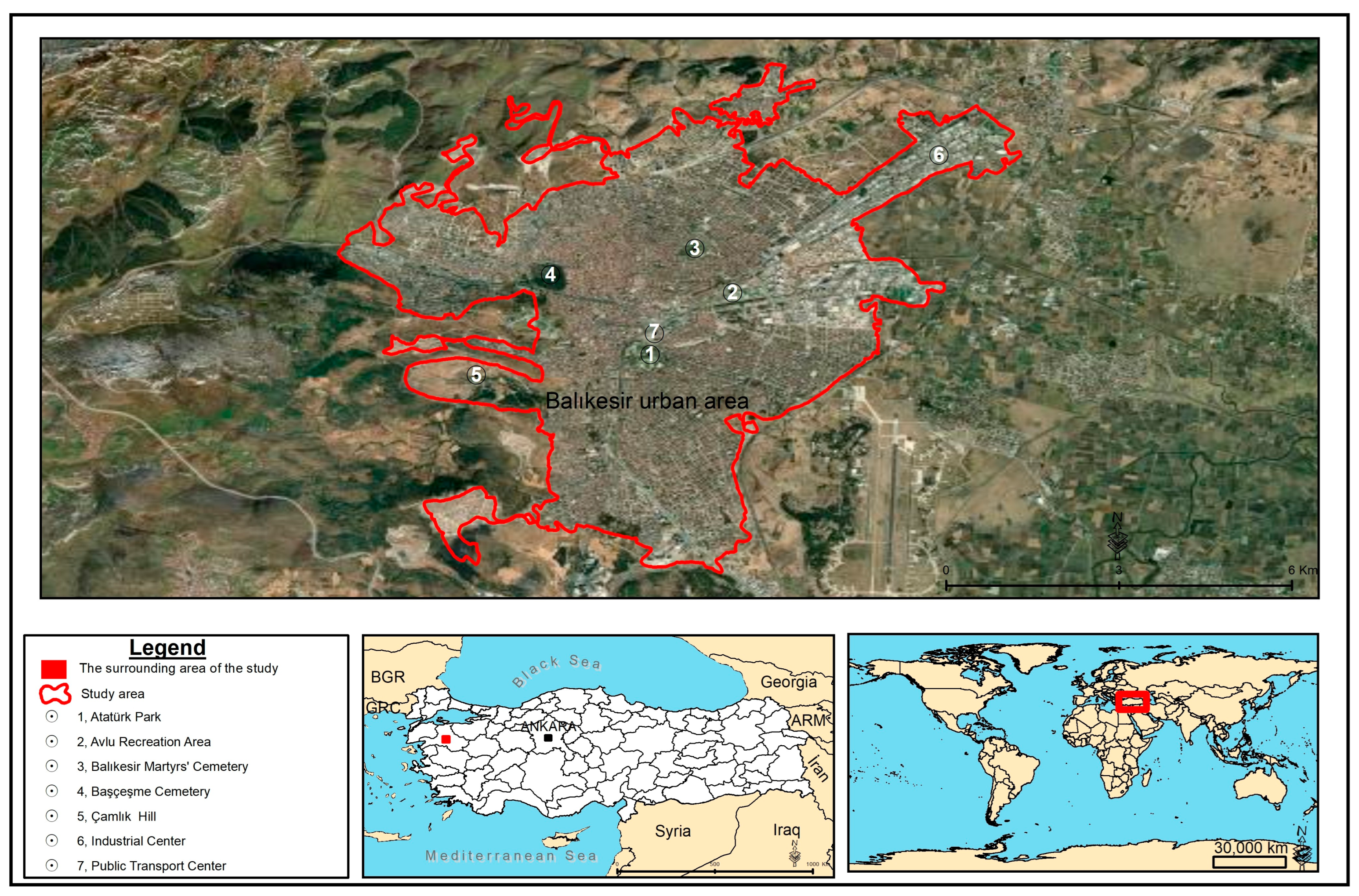
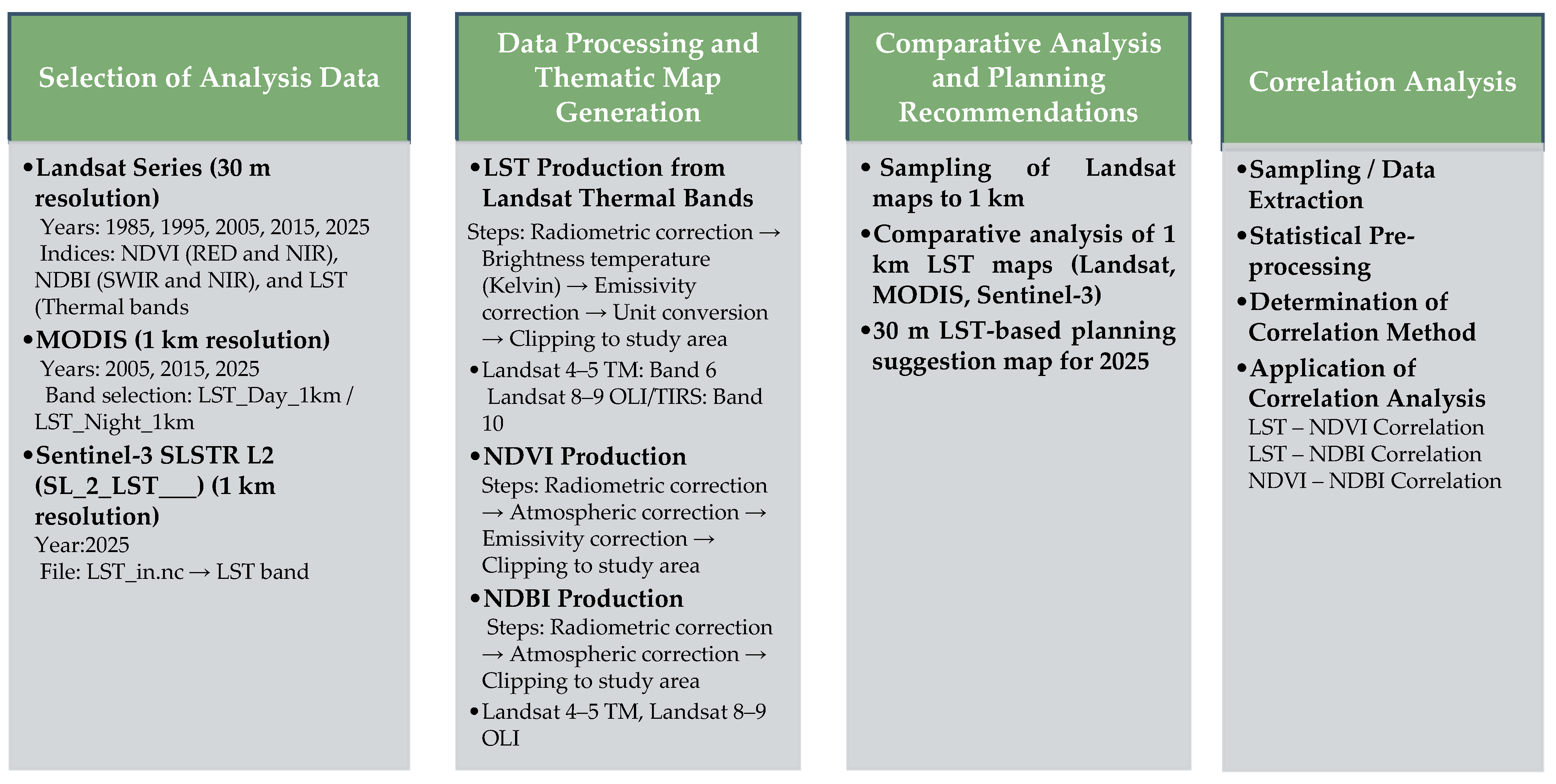
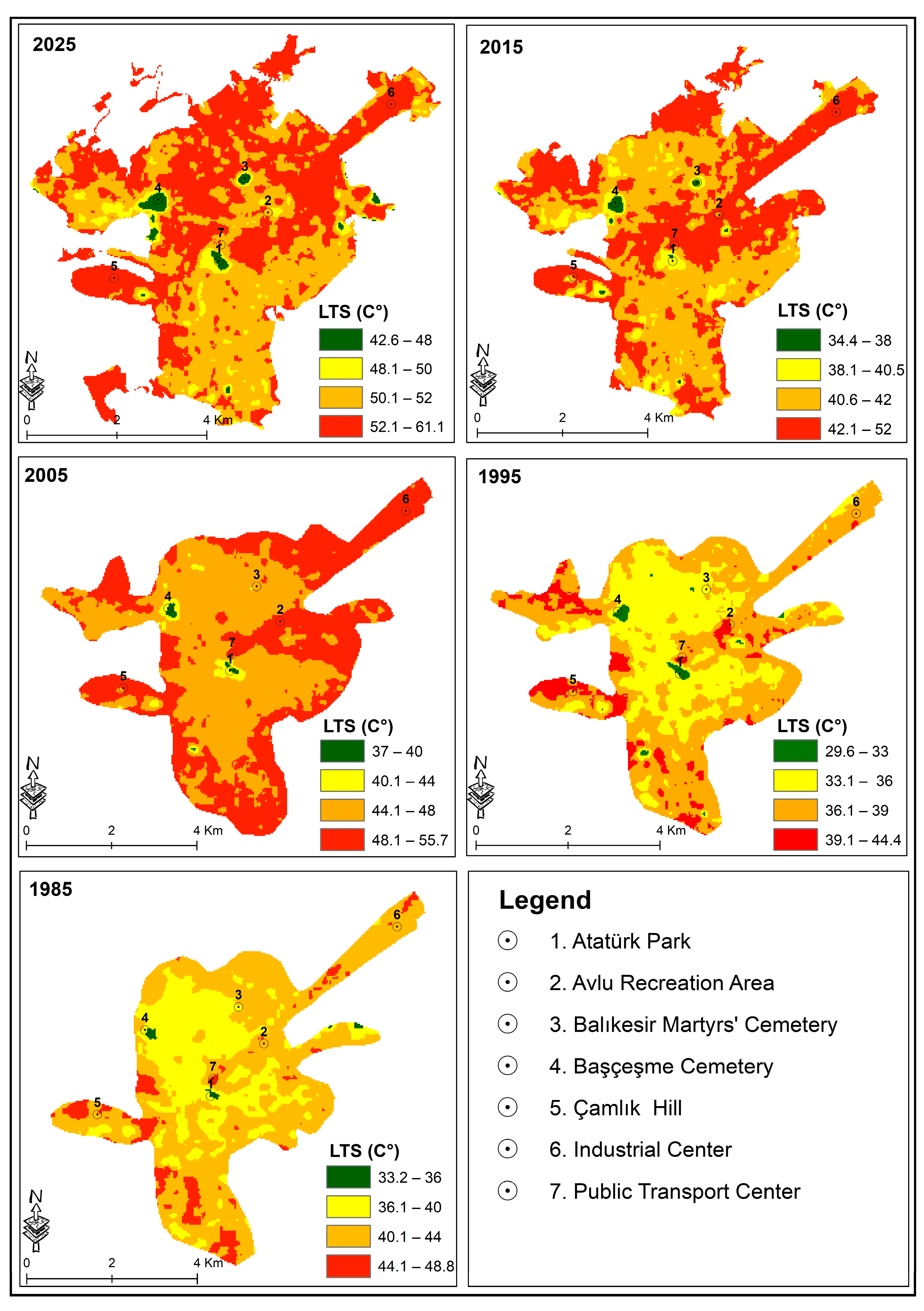
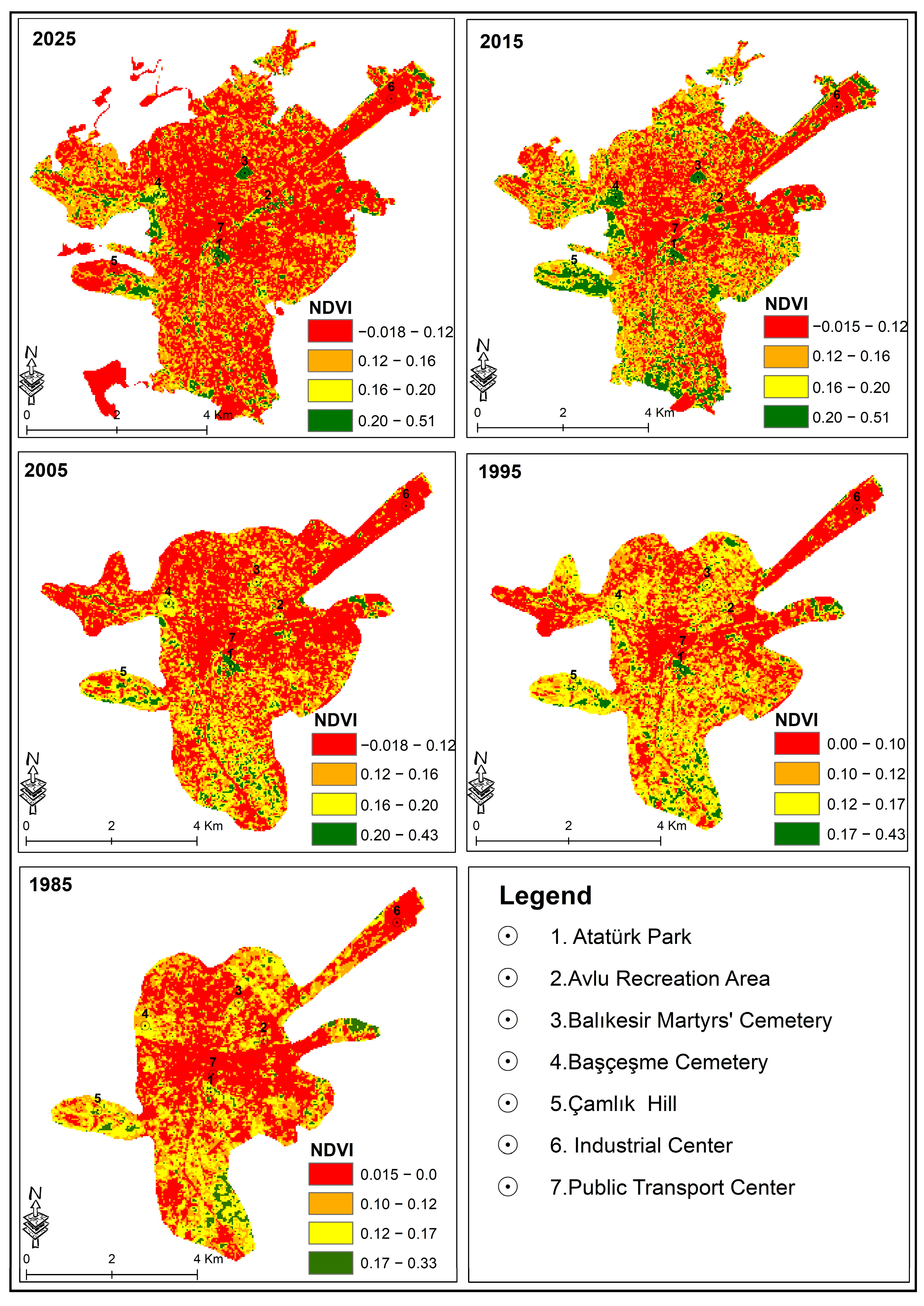
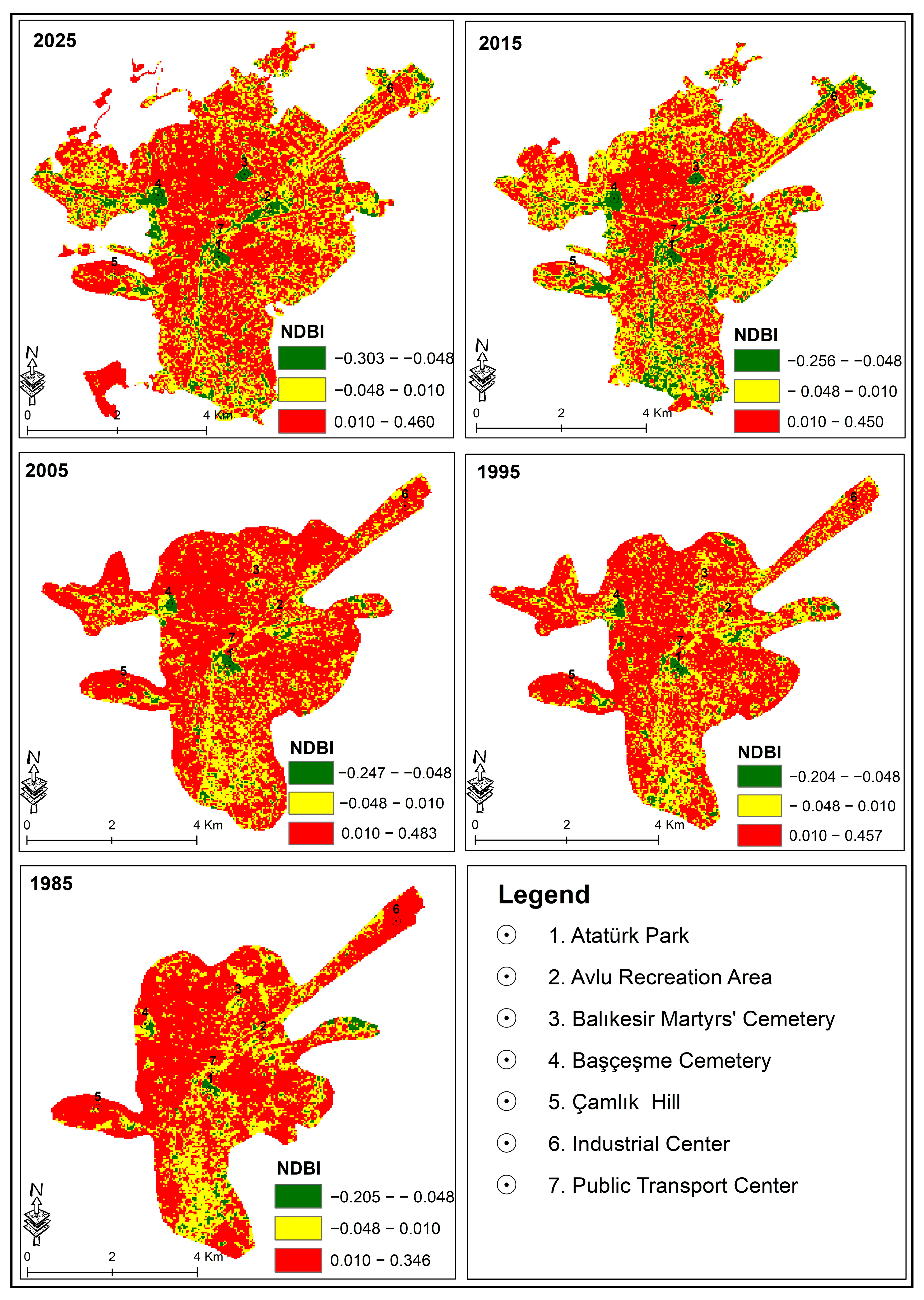
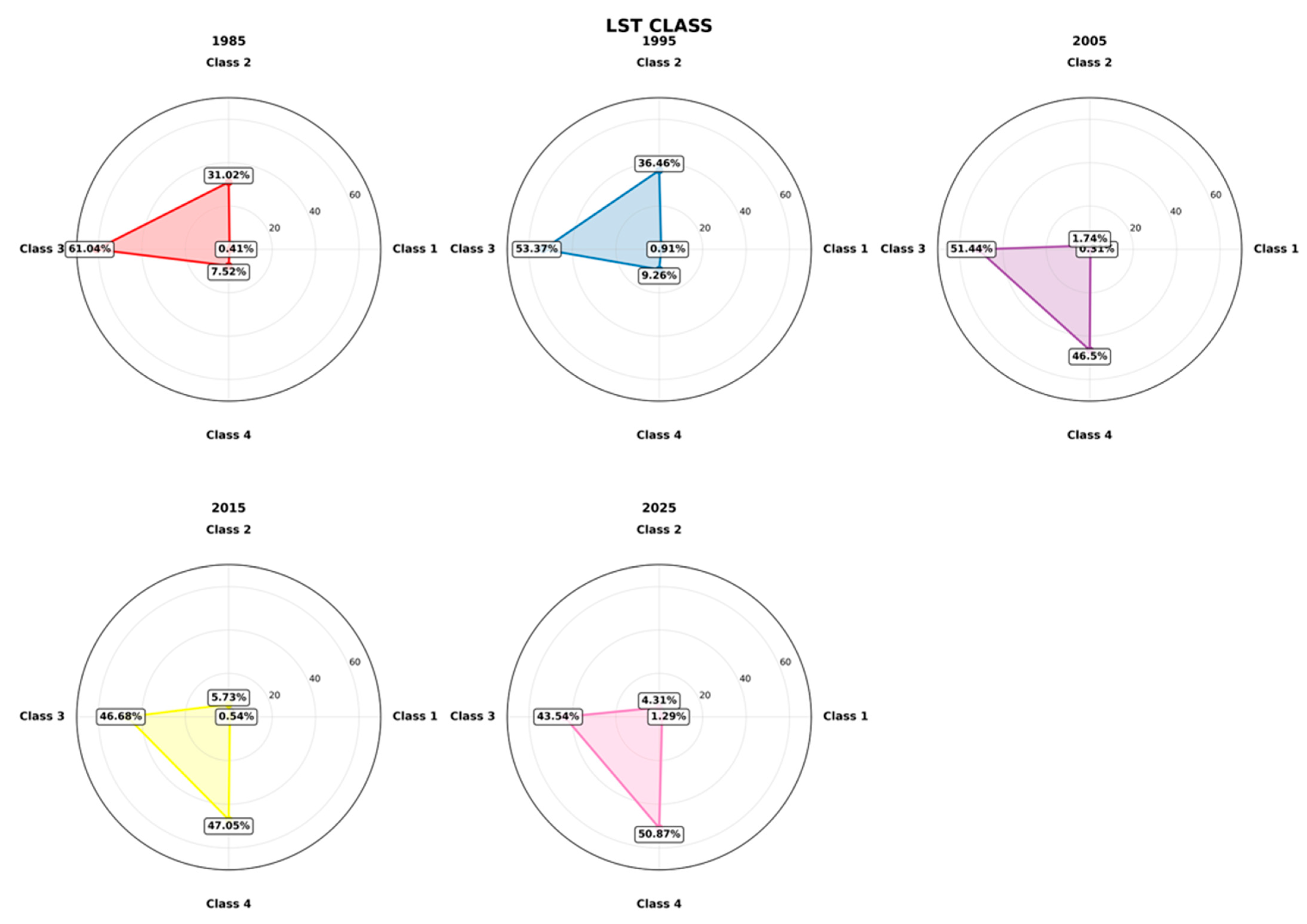
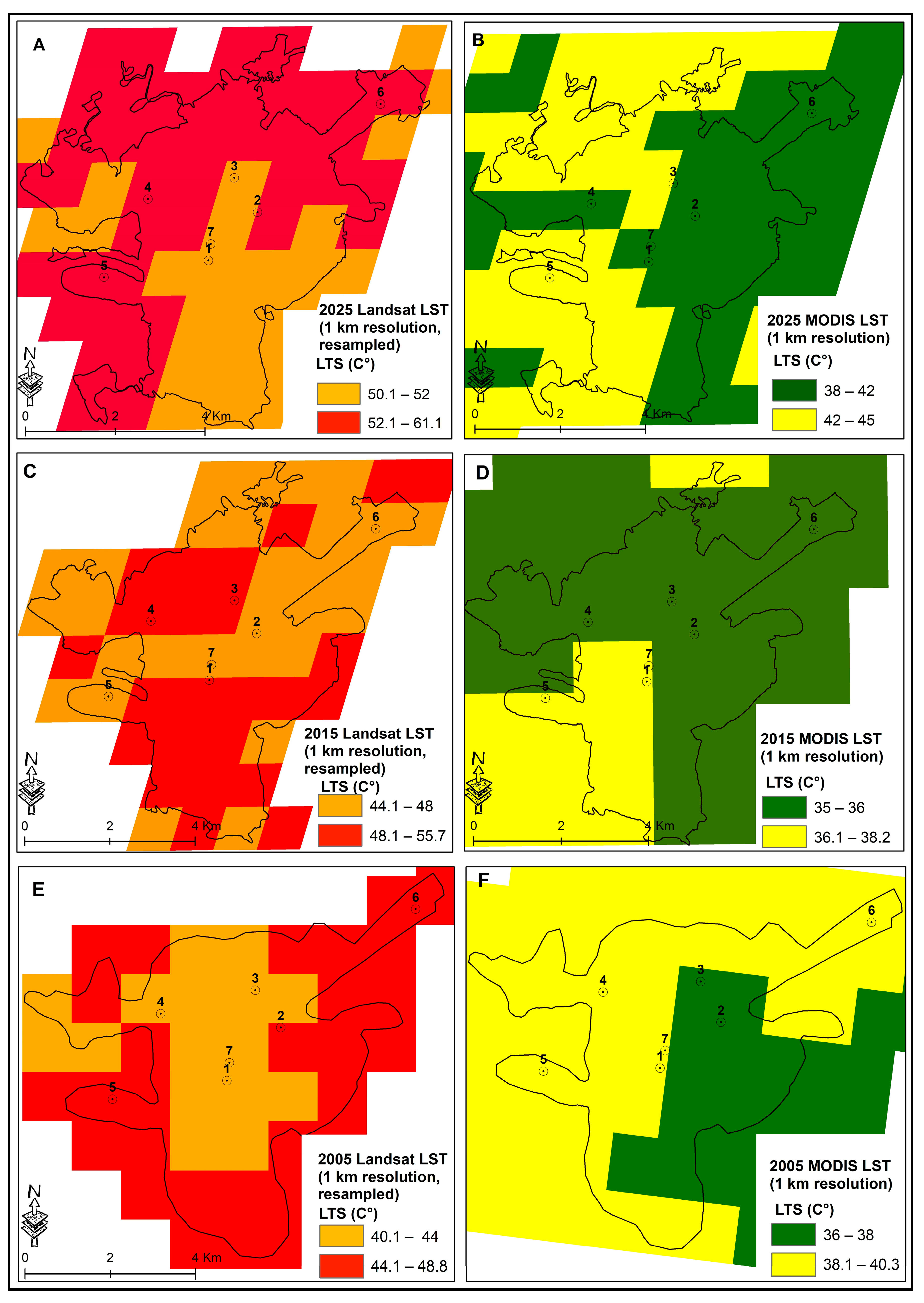
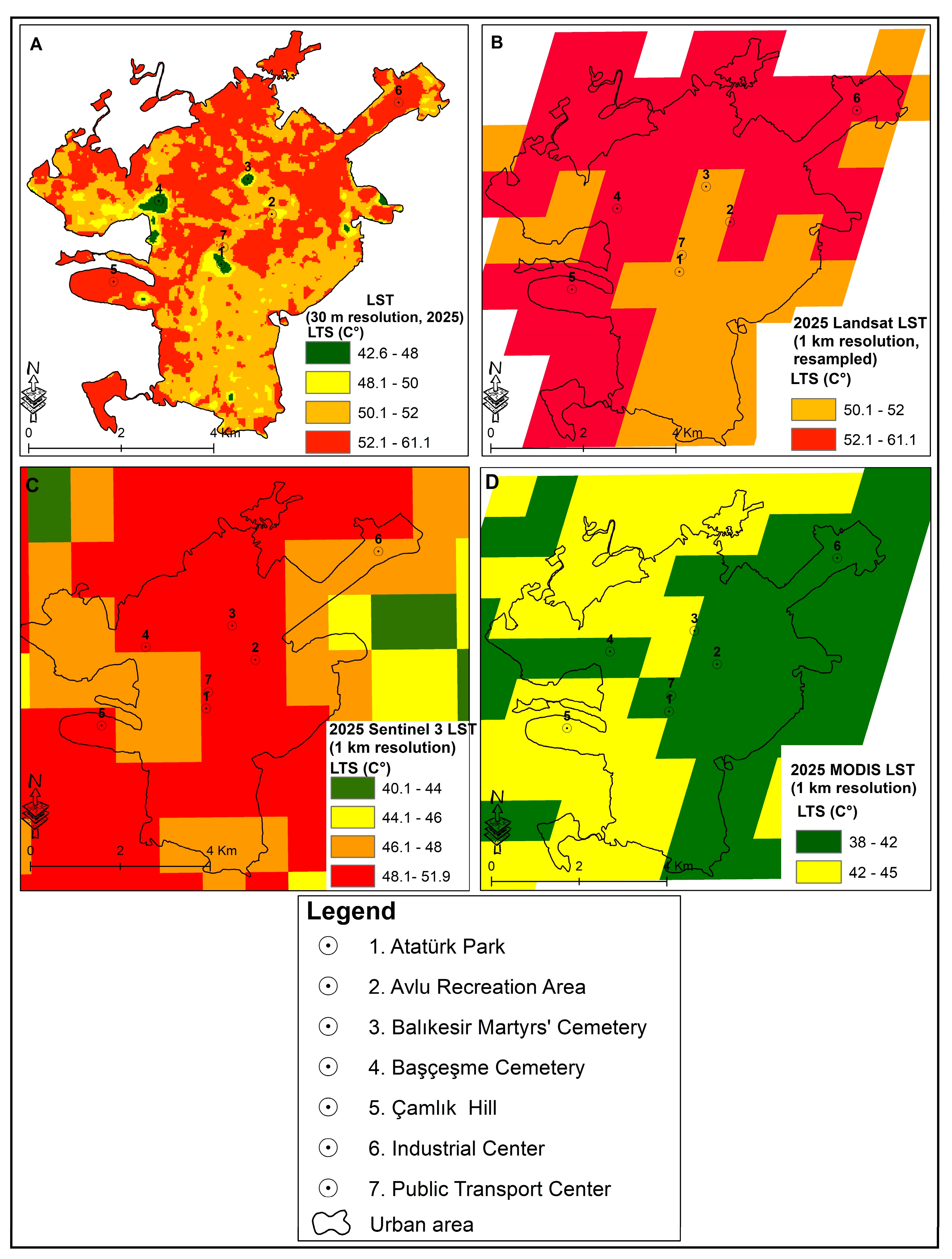
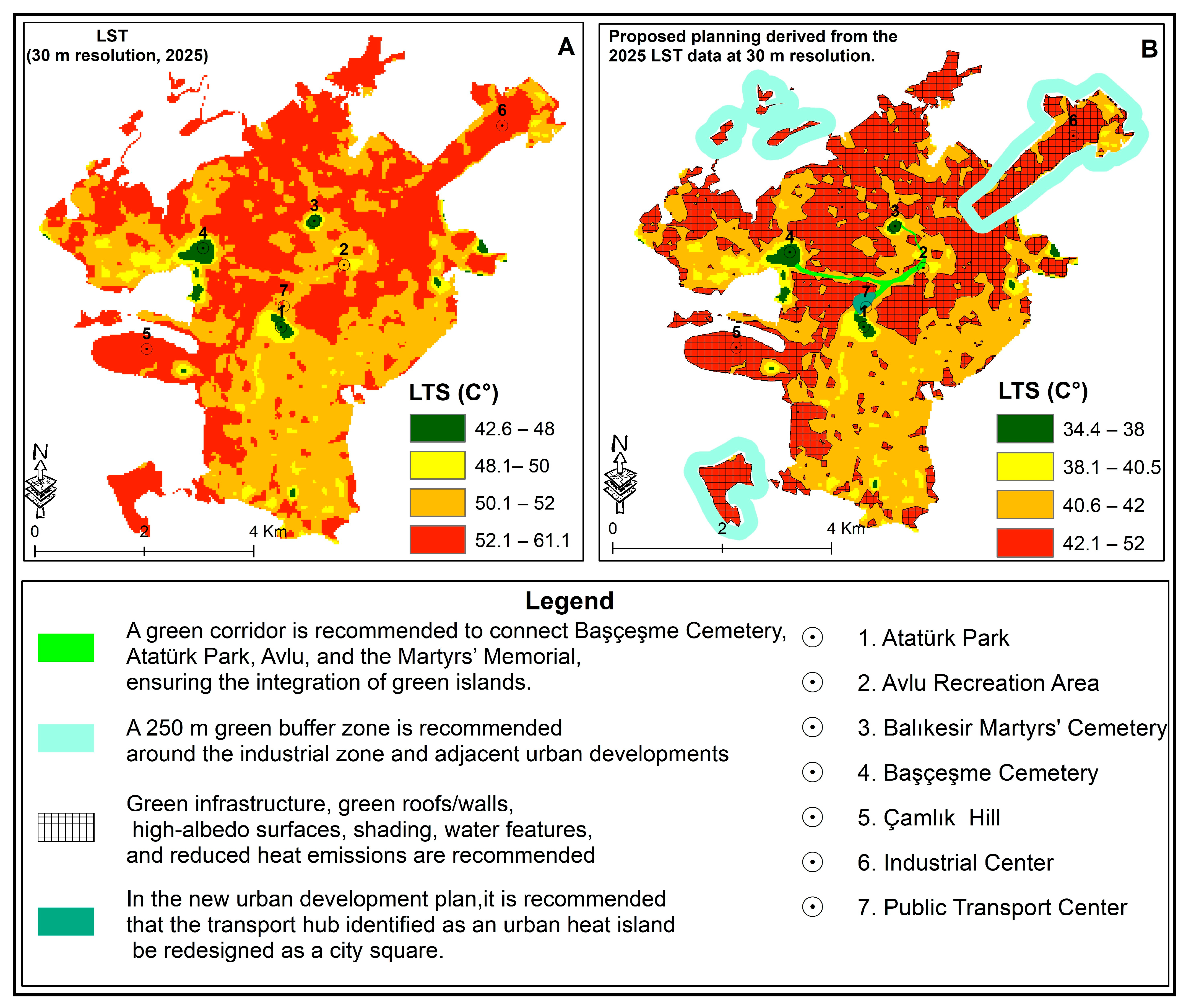
| Satellite Mission | Indicator | Band No. | Band Name |
|---|---|---|---|
| Landsat 4 (TM) | LST | 6 | TIR |
| NDVI | 3 | Red | |
| NDVI | 4 | NIR | |
| NDBI | 5 | SWIR1 | |
| NDBI | 4 | NIR | |
| Landsat 5 (TM) | LST | 6 | TIR |
| NDVI | 3 | Red | |
| NDVI | 4 | NIR | |
| NDBI | 5 | SWIR1 | |
| NDBI | 4 | NIR | |
| Landsat 8 (OLI/TIRS) | LST | 10 | ST_B10 |
| NDVI | 4 | Red | |
| NDVI | 5 | NIR | |
| NDBI | 6 | SWIR1 | |
| NDBI | 5 | NIR | |
| Landsat 9 (OLI-2/TIRS-2) | LST | 10 | ST_B10 |
| NDVI | 4 | Red | |
| NDVI | 5 | NIR | |
| NDBI | 6 | SWIR1 | |
| NDBI | 5 | NIR |
| NDVI | NDBI | LST | ||||
|---|---|---|---|---|---|---|
| Class | Percent% | Class | Percent% | Class | Percent% | |
| 1985 | 0.014–0.101 | 46.99 | −0.204–0.048 | 2.74 | 33.2–36 | 0.41 |
| 0.101–0.120 | 26.21 | −0.048–0.010 | 26.00 | 36.1–40 | 31.02 | |
| 0.120–0.165 | 23.17 | 0.010–0.189 | 71,26 | 40.1–44 | 61.04 | |
| 0.165–0.333 | 3.64 | 44.1–48.8 | 7.52 | |||
| 1995 | 0.000–0.101 | 39.17 | −0.204–0.024 | 3.64 | 29.6–33 | 0.91 |
| 0.101–0.120 | 25.82 | −0.024–0.010 | 27.37 | 33.1–36 | 36.46 | |
| 0.120–0.165 | 29.75 | 0.010–0.457 | 68.99 | 36.1–39 | 53.37 | |
| 0.165–0.433 | 5.25 | 39.1–44.4 | 9.26 | |||
| 2005 | −0.027–0.101 | 57.21 | −0.204–0.048 | 2.84 | 37–40 | 0.31 |
| 0.101–0.120 | 20.09 | −0.048–0.010 | 23.87 | 40.1–44 | 1.74 | |
| 0.120–0.165 | 18.77 | 0.010–0.483 | 73.29 | 44.1–48 | 51.44 | |
| 0.165–0.430 | 3.94 | 48.1–55.7 | 46.50 | |||
| 2015 | −0.014–0.120 | 40.36 | −0.256–0.048 | 10.47 | 34.3–38 | 0.54 |
| 0.120–0.160 | 29.35 | −0.048–0.010 | 40.33 | 38.01–40 | 5.73 | |
| 0.160–0.200 | 18.16 | 0.010–0.483 | 49.20 | 40.01–42 | 46.68 | |
| 0.200–0.513 | 12.12 | 42.01–52 | 47.05 | |||
| 2025 | −0.017–0.120 | 62.37 | −0.303–0.048 | 7.15 | 42.6–48 | 1.29 |
| 0.120–0.160 | 23.85 | −0.048–0.010 | 31.50 | 48.1–50 | 4.31 | |
| 0.160–0.200 | 8.77 | 0.010–0.403 | 61.35 | 50.1–52 | 43.54 | |
| 0.200–0.505 | 5.01 | 52.1–61.1 | 50.87 | |||
| Variable Pair | Min. | Max. | Mean | Standard Deviation | Correlation (r) | Strength | 95% CI | p | n | |
|---|---|---|---|---|---|---|---|---|---|---|
| 1985 | LST–NDBI | 33.24 | 48.76 | 41.15 | 2.00 | +0.30 | Moderate | [0.288–0.312] | <0.001 | 22,039 |
| NDVI–LST | 0.01 | 0.33 | 0.11 | 0.03 | −0.50 | Moderate | [−0.510–−0.490] | <0.001 | 22,039 | |
| NDBI–NDVI | −0.2050 | 0.19 | 0.02 | 0.03 | −0.65 | Strong | [–0.658–−0.642] | <0.001 | 22,039 | |
| 1995 | NDVI-LST | −0.2050 | 0.189 | 0.021 | 0.030 | −0.557 | Moderate | [+0.502, +0.520] | <0.001 | 25,451 |
| LST-NDBI | 33.243 | 48.761 | 41.147 | 1.996 | +0.5112 | Moderate | [−0.565, −0.548] | <0.001 | 25,451 | |
| NDBI-NDVI | 0.015 | 0.333 | 0.107 | 0.030 | −0.5505 | Moderate | [−0.559, −0.542] | <0.001 | 25,451 | |
| 2005 | LST–NDBI | 369.994 | 556.925 | 480.223 | 23.183 | +0.4349 | Moderate | [+0.425, +0.445] | <0.001 | 28,638 |
| NDVI–LST | −0.0270 | 0.4306 | 0.0996 | 0.0353 | −0.4789 | Moderate | [−0.488, −0.469] | <0.001 | 28,638 | |
| NDBI–NDVI | −0.2469 | 0.4834 | 0.0231 | 0.0332 | −0.5884 | Moderate–Strong | [−0.596, −0.581] | <0.001 | 28,638 | |
| 2015 | LST–NDBI | 34.36 | 52.50 | 42.10 | 1.35 | +0.4822 | Moderate | [0.474, 0.490] | <0.001 | 34,408 |
| LST–NDVI | −0.0149 | 0.5133 | 0.1381 | 0.0544 | −0.4421 | Moderate | [−0.451, −0.434] | <0.001 | 34,408 | |
| NDBI–NDVI | −0.2562 | 0.2117 | 0.0046 | 0.0432 | −0.7444 | Strong | [–0.749, −0.740] | <0.001 | 34,408 | |
| 2025 | LST–NDBI | 42.59 | 61.09 | 52.16 | 1.70 | +0.6130 | Strong | [+0.606, +0.620] | <0.001 | 34,408 |
| LST–NDVI | −0.3032 | 0.2079 | 0.0145 | 0.0415 | −0.6087 | Strong | [−0.615, −0.602] | <0.001 | 34,408 | |
| NDBI–NDVI | −0.2562 | 0.2117 | 0.0046 | 0.0432 | −0.7261 | Strong | [−0.731, −0.721] | <0.001 | 34,408 |
Disclaimer/Publisher’s Note: The statements, opinions and data contained in all publications are solely those of the individual author(s) and contributor(s) and not of MDPI and/or the editor(s). MDPI and/or the editor(s) disclaim responsibility for any injury to people or property resulting from any ideas, methods, instructions or products referred to in the content. |
© 2025 by the authors. Licensee MDPI, Basel, Switzerland. This article is an open access article distributed under the terms and conditions of the Creative Commons Attribution (CC BY) license (https://creativecommons.org/licenses/by/4.0/).
Share and Cite
Altıner, F.; Bingöl, F. Spatio-Temporal Assessment of Land Surface Temperature, Vegetation Cover, and Built-Up Areas Using LST, NDVI, and NDBI in Balıkesir, Türkiye (1985–2025). Sustainability 2025, 17, 9245. https://doi.org/10.3390/su17209245
Altıner F, Bingöl F. Spatio-Temporal Assessment of Land Surface Temperature, Vegetation Cover, and Built-Up Areas Using LST, NDVI, and NDBI in Balıkesir, Türkiye (1985–2025). Sustainability. 2025; 17(20):9245. https://doi.org/10.3390/su17209245
Chicago/Turabian StyleAltıner, Figen, and Faruk Bingöl. 2025. "Spatio-Temporal Assessment of Land Surface Temperature, Vegetation Cover, and Built-Up Areas Using LST, NDVI, and NDBI in Balıkesir, Türkiye (1985–2025)" Sustainability 17, no. 20: 9245. https://doi.org/10.3390/su17209245
APA StyleAltıner, F., & Bingöl, F. (2025). Spatio-Temporal Assessment of Land Surface Temperature, Vegetation Cover, and Built-Up Areas Using LST, NDVI, and NDBI in Balıkesir, Türkiye (1985–2025). Sustainability, 17(20), 9245. https://doi.org/10.3390/su17209245








